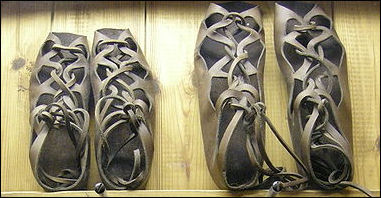Lecture Summary
This weeks lecture covered the time span from 35000 BCE to the year zero. We covered the origins of writing and language, from cave art dating back 40 000 years to the perfection of the Chinese written language on paper. Something I found particularly fascinating was the idea of the evolution of Korean language. It is the youngest alphabet in the world. In a time where reading and writing was reserved for the upper classes, Korean Hangul was easy to read, write, and speak due to its phonetic nature.
Weekly Research
First century Rome was a tumultuous but successful place. After years of unrest, the years 0-100 AC would contain more victories for Rome than ever before, reaching its peak just after the end of the first century. Roman people were proud of their accomplishments and of their empire, and dressed in a distinguishable style to reflect this.
The average Roman man often came packaged in a wool toga or tunic, with individual styles for each gender and age. Common men wore plain white, and were officially allowed to wear one ring intended to seal letters with wax. However, some defied this rule and adorned themselves and their clothing when possible to show off. Casual wear consisted of tunics (or tunica) were mid thigh length dresses, often worn with a hooded cape (a paenula) and broach. Standard footwear was strapped sandals, custom to the Mediterranean climate. Pants were classified as barbaric, and did not make an appearance in Rome unless in military wear. Togas were more formal, and signified status more so than the average tunic.
- White applied to all men
- Off-white and purple to upperclassmen
- Bleached fabrics for politicians
- Dark wool togas were worn after a loved one had passed
- Purple and gold was reserved for dignitaries, generals, and eventually emperors
Women were dressed modestly. Their dress consisted of floor length, long sleeved woolen togas. Togas would later be exclusive to men in the second century. Women of a lower class could also wear tunics, but they were more fitted to the female body with belts. Women of wealth and status could wear a stola, a sign of a dignified married woman. It was a piece of cloth (wool, linen, or silk in higher classes) intricately wrapped around ones upper body. A palla, a long shawl like piece of rectangular cloth, could be worn by any woman and would have similar effect. Pallas were more casual, and excluded the face, therefore being less formal. Women of all classes loved jewelry. It was more commonly found on higher class women, the pieces featuring intricate designs and subjects.
Status was expressed through dress as well. It was thought that the more fabric a person has on, the more they can afford, the wealthier they are. Rich colours and high quality fabrics also represented wealth. Jewelry, high quality cosmetics, and adornments did too. Orange clothing was gaudy and flashy, where purple and gold signified class and royalty.



Photos: https://www.romawonder.com/fashion-ancient-rome-togas-underwear-wedding-dresses/
http://factsanddetails.com/world/cat56/sub369/item2069.html
Bibliography
https://www.vox.com/world/2018/6/19/17469176/roman-empire-maps-history-explained
Lee, Timothy B. “40 Maps That Explain the Roman Empire.” Vox, Vox, 19 Aug. 2014, www.vox.com/world/2018/6/19/17469176/roman-empire-maps-history-explained.
https://www.historyonthenet.com/the-romans-clothing/
“The Romans – Clothing.” History, 19 Mar. 2018, www.historyonthenet.com/the-romans-clothing/
https://owlcation.com/humanities/Womens-Clothes-in-Ancient-Rome
Lewis, Linnea. “Women’s Clothes in Ancient Rome.” Owlcation, Owlcation, 24 Jan. 2018, owlcation.com/humanities/Womens-Clothes-in-Ancient-Rome.
Bowman, Karen. Corsets and Codpieces: a History of Outrageous Fashion, from Roman Times to the Modern Era. Skyhorse Publishing, 2016.
Cummings, Valerie, et al. The Dictionary of Fashion History: Based on a Dictionary of English Costume, 900-1900 by C.W. and P.E. Cunnington and Charles Beard, Now Completely Revised, Updated and Supplemented to the Present Day by Valerie Cumming. Berg, 2010.